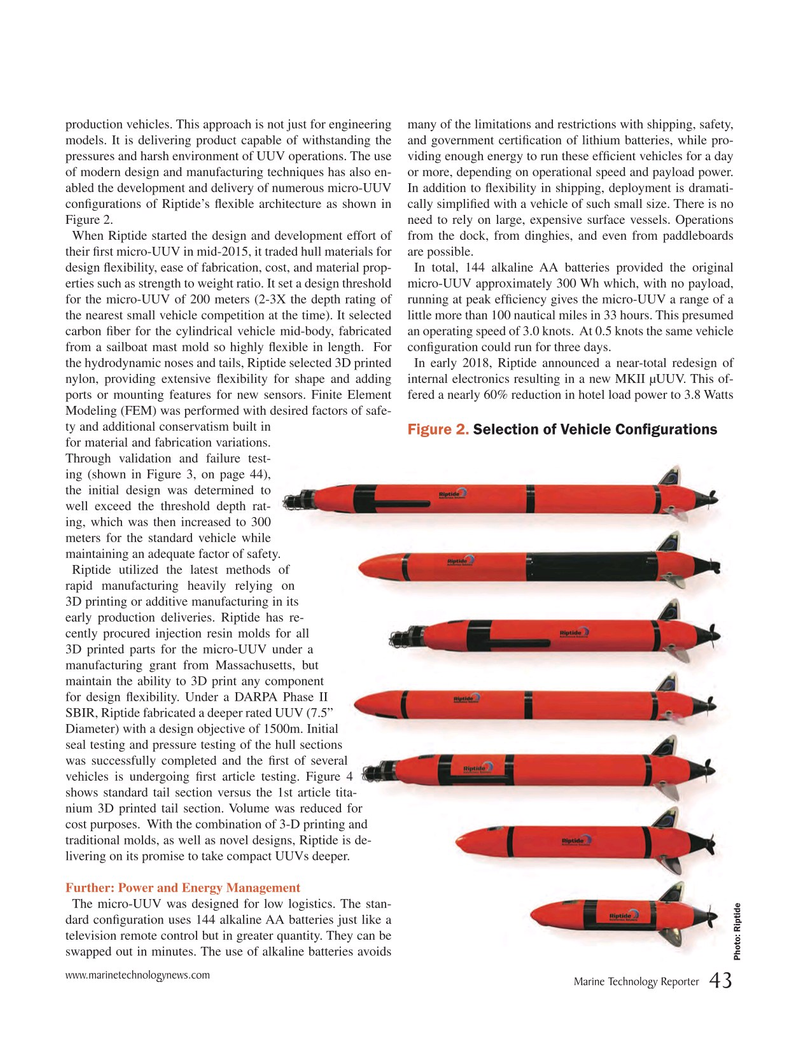
Page 43: of Marine Technology Magazine (June 2018)
Underwater Defense
Read this page in Pdf, Flash or Html5 edition of June 2018 Marine Technology Magazine
production vehicles. This approach is not just for engineering many of the limitations and restrictions with shipping, safety, models. It is delivering product capable of withstanding the and government certi? cation of lithium batteries, while pro- pressures and harsh environment of UUV operations. The use viding enough energy to run these ef? cient vehicles for a day of modern design and manufacturing techniques has also en- or more, depending on operational speed and payload power. abled the development and delivery of numerous micro-UUV In addition to ? exibility in shipping, deployment is dramati- con? gurations of Riptide’s ? exible architecture as shown in cally simpli? ed with a vehicle of such small size. There is no
Figure 2. need to rely on large, expensive surface vessels. Operations
When Riptide started the design and development effort of from the dock, from dinghies, and even from paddleboards their ? rst micro-UUV in mid-2015, it traded hull materials for are possible.
design ? exibility, ease of fabrication, cost, and material prop- In total, 144 alkaline AA batteries provided the original erties such as strength to weight ratio. It set a design threshold micro-UUV approximately 300 Wh which, with no payload, for the micro-UUV of 200 meters (2-3X the depth rating of running at peak ef? ciency gives the micro-UUV a range of a the nearest small vehicle competition at the time). It selected little more than 100 nautical miles in 33 hours. This presumed carbon ? ber for the cylindrical vehicle mid-body, fabricated an operating speed of 3.0 knots. At 0.5 knots the same vehicle from a sailboat mast mold so highly ? exible in length. For con? guration could run for three days. the hydrodynamic noses and tails, Riptide selected 3D printed In early 2018, Riptide announced a near-total redesign of nylon, providing extensive ? exibility for shape and adding internal electronics resulting in a new MKII µUUV. This of- ports or mounting features for new sensors. Finite Element fered a nearly 60% reduction in hotel load power to 3.8 Watts
Modeling (FEM) was performed with desired factors of safe- ty and additional conservatism built in
Figure 2. Selection of Vehicle Con? gurations for material and fabrication variations.
Through validation and failure test- ing (shown in Figure 3, on page 44), the initial design was determined to well exceed the threshold depth rat- ing, which was then increased to 300 meters for the standard vehicle while maintaining an adequate factor of safety.
Riptide utilized the latest methods of rapid manufacturing heavily relying on 3D printing or additive manufacturing in its early production deliveries. Riptide has re- cently procured injection resin molds for all 3D printed parts for the micro-UUV under a manufacturing grant from Massachusetts, but maintain the ability to 3D print any component for design ? exibility. Under a DARPA Phase II
SBIR, Riptide fabricated a deeper rated UUV (7.5”
Diameter) with a design objective of 1500m. Initial seal testing and pressure testing of the hull sections was successfully completed and the ? rst of several vehicles is undergoing ? rst article testing. Figure 4 shows standard tail section versus the 1st article tita- nium 3D printed tail section. Volume was reduced for cost purposes. With the combination of 3-D printing and traditional molds, as well as novel designs, Riptide is de- livering on its promise to take compact UUVs deeper.
Further: Power and Energy Management
The micro-UUV was designed for low logistics. The stan- dard con? guration uses 144 alkaline AA batteries just like a television remote control but in greater quantity. They can be swapped out in minutes. The use of alkaline batteries avoids
Photo: Riptide www.marinetechnologynews.com
Marine Technology Reporter 43
MTR #5 (34-49).indd 43 MTR #5 (34-49).indd 43 5/29/2018 12:05:43 PM5/29/2018 12:05:43 PM

 42
42

 44
44
